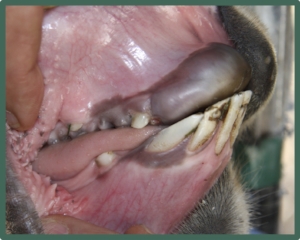Common Signs of Alpaca Dental Issues
Alpacas of either sex can develop dental problems at any age.
In females serious tooth problems are often more noticeable during late gestation or lactation when they have the highest nutritional requirements.
If your alpaca is showing one or more of the following symptoms they may be caused by dental problems.
Loss of body condition - especially if the other animals are doing well in the same environment. Regular body condition scoring or weighing can often identify these alpacas.
A reluctance to eat, accompanied by obvious pain on chewing. Quite often these animals do not finish their share of rations.
Not chewing cud.
Feed spillage from the mouth whilst chewing.
Undigested food in droppings.
Swelling around the jaw area. Often the swelling comes and goes as the animal makes protective pads from hay or grass to alleviate pain during chewing. (See article in “Alpacas Australia” Magazine Issue 52, Autumn 2007)
Unhappy demeanor.
Jaw abscess.
What Are The Most Common Dental Issues?
Skull Showing Basic Dental Anatomy
It is essential as their carers that we understand the basics of alpaca dental anatomy and the effects dental problems can have on the overall health and welfare of our alpacas.
See below for some of the most common problems.
Incisors
Incisors are the 'cutting teeth' at the front of the mouth and are used to bite off grass and leaves and also occasionally useful for scratching. One of the most common problems seen with incisors is when they become too long, protrude beyond the dental pad and can be seen sticking out between the lips.
If the incisors do not meet the dental pad they won't wear down and will keep getting longer. This makes it difficult for the animal to graze, causes callouses and bruises to the dental pad and may cut the lips. These teeth need trimming. Left untrimmed the incisors will block the entrance to the mouth resulting in discomfort and loss of body condition.
This can occur in animals of all ages.
Incisors Before Trimming
Incisors After Trimming
Fighting Teeth
Males generally have large, well developed fighting teeth located both sides of the mouth behind the incisors. They develop when the alpaca is around three. Fighting teeth are very sharp, designed to rip and tear during fights for dominance and should be trimmed to ensure the safety of their paddock companions and handlers.
Fighting teeth can also cause discomfort by digging into the opposing jaw, cutting the gum and lips.
Fighting Teeth Before Trimming
Fighting Teeth After Trimming
Molars
The molars are the teeth at the back of the mouth and are often referred to as cheek teeth. These teeth grind the food to a consistency suitable for swallowing. The healthier these teeth are the better the alpaca can chew and ultimately digest its food. Some of the problems that can occur with molars are;
A large, painful ulcer (red arrow). The result of the sharp tooth point (blue arrow)
Sharp points cutting the soft tissue of the cheeks and tongue
Sracked or split teeth
Protuberant (over-long) molars gouging into the opposing jaw
Ulcers
Infected teeth and gums
Loose teeth
Mis-placed teeth
Retained baby (milk) teeth
Extra teeth
Abscesses
All of these problems are painful and will cause the alpaca to eat less food resulting in a loss of body condition, a decline in milk production in females and affect general heath in all alpacas.
Often these issues can only be identified and addressed using specialised equipment that enables you to hold the mouth open, see inside and take necessary action to fix the problem and relieve pain.







